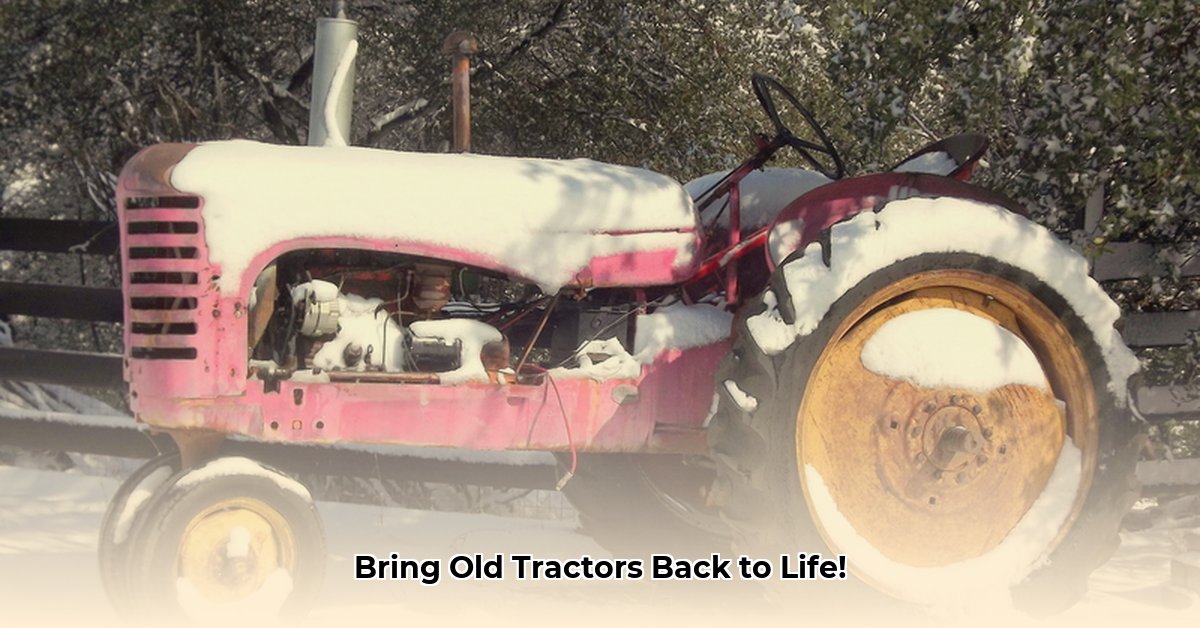
Bringing an old tractor back to life is incredibly rewarding, but it requires a methodical approach. This guide, designed for tractor owners of all skill levels, walks you through the process, from pre-start checks to long-term maintenance, ensuring your old workhorse runs smoothly for years to come. We'll focus on safety, sustainability, and practical, step-by-step instructions. For more in-depth information, check out this comprehensive guide.
Pre-Start Inspection: Preparing Your Tractor
Before attempting to start your tractor, a thorough inspection is paramount. This prevents unexpected problems and ensures a safe, successful start. Think of it as a pre-flight check for your machine!
1. Fuel System Check: Old fuel is often contaminated. Drain the fuel tank completely. Flush the tank and fuel lines with a fuel system cleaner (designed for older engines) and install a new fuel filter. This removes harmful sediment that can clog your carburetor or fuel injectors.
2. Lubrication Assessment: Check the engine oil level and condition. A complete oil change is highly recommended, especially if the tractor has been sitting unused for a long time. Dirty oil acts like sandpaper, wearing down your engine's vital components.
3. Cooling System Examination: Inspect the radiator and all hoses for leaks, cracks, or signs of corrosion. Drain and flush the entire cooling system with clean coolant. A clean cooling system is essential for preventing overheating.
4. Battery Evaluation: Test your battery's voltage with a multimeter (a device that measures electrical voltage). You may need a jump start, a full charge, or a battery replacement.
5. Electrical System Check: Inspect all electrical connections for corrosion and ensure they are secure. Clean your spark plugs and distributor cap (if applicable). A weak spark can prevent the engine from starting.
Starting Your Tractor: A Step-by-Step Process
With the pre-start inspection complete, you can attempt to start your tractor. Remember: safety first! Always wear safety glasses.
Step 1: Gear Selection: Ensure the gear selector is in neutral. This prevents accidental movement.
Step 2: Engine Priming (If Necessary): Many older tractors require manual engine priming. Refer to your owner's manual for specific instructions. This primes the fuel system, ensuring adequate fuel for ignition.
Step 3: Initial Cranking Attempt: Attempt to crank the engine. Don't hold the key (or starter cord) down continuously. Give the engine a few seconds to crank, then pause briefly before trying again. Prolongued cranking can damage the starter motor.
Step 4: Troubleshooting (If Needed): If the engine doesn't start, systematically check fuel delivery (fuel pump, lines, filter), spark (spark plugs, ignition system), and compression (checking for compression leaks). Multiple factors can contribute to a no-start condition.
Step 5: Successful Start: If the engine starts, let it idle at a low speed for a few minutes. Monitor for unusual noises or leaks.
Step 6: Post-Start Inspection: Once warmed up, gradually increase the engine speed. Monitor oil pressure and engine temperature gauges.
Ongoing Maintenance: Extending Your Tractor's Life
Regular maintenance is key to ensuring your tractor's longevity and reliable performance. Don't underestimate the importance of preventative care. A small investment in time and resources saves you much larger expenses down the road.
1. Fluid Changes: Regularly change the engine oil, coolant, and fuel filter, using high-quality fluids specified in your owner's manual. Regular fluid changes significantly extend engine life.
2. Regular Inspections: Perform regular visual inspections for leaks, loose components, and signs of wear. Early detection of minor issues prevents major breakdowns.
3. Cleaning: Keeping your tractor clean protects against corrosion and makes future maintenance easier. Clean the exterior, as well as accessible engine components.
Troubleshooting Common Problems
Here's a quick reference for common issues and solutions:
| Problem | Possible Cause(s) | Solutions |
|---|---|---|
| Engine cranks, but won't start | Dead battery, faulty ignition system, fuel delivery issues | Check battery voltage, test the ignition system, inspect fuel lines & filter. |
| Engine starts, but dies | Fuel starvation, carburetor problems, intake air leaks | Check fuel supply, clean or rebuild the carburetor, inspect for air leaks. |
| Engine runs rough | Worn spark plugs, dirty air filter, carburetor needs servicing | Replace spark plugs, clean or replace air filter, clean/adjust the carburetor. |
| Overheating | Low coolant, radiator blockage, faulty thermostat | Check coolant level, flush the radiator, replace the thermostat. |
Remember to dispose of used fluids responsibly. With proper care, your old tractor will reward you with years of dependable service. The satisfaction of restoring and operating your own classic tractor is unmatched!